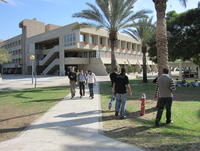-
ISIS and al-Qaeda use social media, Web platforms differently to achieve different ends

The Internet has contributed to the popularity of both al-Qaeda and the Islamic State (ISIS) among would-be jihadists, but the two terror groups use social media and Web platforms differently. Al-Qaeda has been spreading its message via the Internet for nearly two decades, while ISIS is a relative newcomer. Both groups use social media to recruit fighters, but ISIS has successfully developed content that Internet users are likely to share and repost. Such content in the form of violent videos and graphic imagery target young, disillusioned Westerners who are prime for radicalization.
-
-
U.S. should emulate allies in pushing for public-private cybersecurity collaboration
Israeli Prime Minister Benjamin Netanyahu announced last month the formation of a national cyber defense authority to defend civilian networks under the leadership of the Israel National Cyber Bureau.The “U.S. government has a lot to learn from successful examples in allied nations. With more compromise and reform, there is plenty of reason for hope,” says a cybersecurity expert, adding that “a cybersecurity partnership between government, business, and individuals built on trust is possible, and would promote more resilient networks as well as creative thinking on cybersecurity.”
-
-
Federally funded cybersecurity center launched
The National Institute of Standards and Technology’s (NIST) National Cybersecurity Center of Excellence(NCCoE) initiative has awarded the first federally funded research and development center (FFRDC) contract for cybersecurity to MITRE Corp., a nonprofit established to operate FFRDCs. Cybersecurity professionals will work with stakeholders in government, the private sector, and academia to develop low cost and scalable cybersecurity solutions.
-
-
Computing for Ebola Challenge

Researchers at the Network Dynamics and Simulation Science Laboratory (NDSSL) have been using a combination of modeling techniques to predict the spread of the Ebola outbreak. As part of those efforts, the team created an adaptable set of global synthetic populations, allowing for rapid response as the situation continues to unfold. The synthetic populations and other informatics resources are now openly available to aid other researchers and citizen scientists. The NDSSL is hosting a Computing for Ebola Challenge from 3 October to 10 October 2014. The goal of the hackathon is to develop an application to combat the Ebola epidemic. All are welcome to join.
-
-
State, local governments aim to strengthen cybersecurity staff despite shrinking budgets
Due to increased cyberattacks on state and local government servers, many leaders are looking to strengthen the cybersecurity staff on their payrolls. Lower levels of government are also worried about cybercrime due to the large amounts of personal and confidential data that they store. Demand for cybersecurity experts is more than double the workplace demand for IT specialists.
-
-
New Web privacy system would revolutionize surfing safety
Scientists have built a new system that protects Internet users’ privacy while increasing the flexibility for Web developers to build Web applications that combine data from different Web sites, dramatically improving the safety of surfing the Web. The system, “Confinement with Origin Web Labels,” or COWL, works with Mozilla’s Firefox and the open-source version of Google’s Chrome Web browsers and prevents malicious code in a Web site from leaking sensitive information to unauthorized parties, while allowing code in a Web site to display content drawn from multiple Web sites — an essential function for modern, feature-rich Web applications.
-
-
U.S. Cyber Command plans to recruit 6,000 cyber professionals, as U.S. mulls offensive cyber strategy
Last Wednesday, House Intelligence Committee Chairman Mike Rogers (R- Michigan) told reporters that he would like to see the United States adopt a more offensive strategy in cyberspace, but added that the Pentagon, intelligence agencies, and law enforcement must first develop protocols for offensive cyber measures.The following day, U.S. Cyber Command (USCYBERCOM) announced plans to recruit 6,000 cyber professionals and create 133 teams across the country to support the Pentagon in defending the nation’s cyber infrastructure.
-
-
New cyber initiative to put Israel’s Beer-Sheva region on the world’s cyber map
Ben-Gurion University of the Negev is a central component of the new CyberSpark initiative, an ecosystem with all the components which will allow it to attain a position of global leadership in the cyber field. The CyberSpark initiative is the only complex of its type in the world – a government-academic-industry partnership which includes Fortune 500 companies and cyber-incubators, academic researchers and educational facilities, as well as national government and security agencies. The CyberSpark Industry Initiative will serve as a coordinating body for joint cyber industry activities with government agencies, the Israel Defense Force (IDF), and academia.
-
-
$3 million in grants for three pilot projects to improve online security, privacy
The National Institute of Standards and Technology (NIST) the other day announced nearly $3 million in grants that will support projects for online identity protection to improve privacy, security and convenience. The three recipients of the National Strategy for Trusted Identities in Cyberspace (NSTIC) grants will pilot solutions that make it easier to use mobile devices instead of passwords for online authentication, minimize loss from fraud and improve access to state services.
-
-
New approach to computer security: Wrist-bracelet

In a big step for securing critical information systems, such as medical records in clinical settings, researchers have created a new approach to computer security that authenticates users continuously while they are using a terminal and automatically logs them out when they leave or when someone else steps in to use their terminal. The approach, called Zero-Effort Bilateral Recurring Authentication, or ZEBRA, requires the user to wear a bracelet with a built-in accelerometer, gyroscope, and radio on his or her dominant wrist; such bracelets are commonly sold as fitness devices. When the user interacts with a computer terminal, the bracelet records the wrist movement, processes it, and sends it to the terminal.
-
-
$5 million for new cybersecurity building at Ben-Gurion University of the Negev

Ben-Gurion University of the Negev (BGU) is a central component of the new “CyberSpark” initiative, a multi-component cyber eco-system. It is the only complex of its type in the world which is a government-academic-industry partnership and includes Fortune 500 companies and cyber-incubators, academic researchers and educational facilities, as well as national government and security agencies. A $5 million contribution will underwrite construction of the building that will house the Cyber Security Institute.
-
-
Virtually every agency of the U.S. government has been hacked: Experts
DHS’ National Cybersecurity and Communications Integration Center (NCCIC) has so far responded to more than 600,000 cyber incidents this fiscal year; has issued more than 10,000 alerts to recipients to help secure their systems; and in seventy-eight cases deployed DHS experts to provide technical assistance.Robert Anderson, the executive assistant director for the FBI’s Criminal, Cyber, Response, and Services branch, told lawmakers that virtually all agencies of the U.S. government have in some way been hacked.
-
-
Political traffic by Arabs on social media overwhelmingly hostile to, suspicious of U.S.
Researchers found that a great deal of the political and social traffic by Arabs on social media is deeply hostile to and suspicious of the United States. U.S. officials are concerned that Internet users in the Arab world understand history and current events in ways fundamentally different from the American version. “Suspicion and opposition to U.S. foreign policy appear to be so deep and so widely shared, even by those on opposite sides of other contentious issues, that it’s hard to imagine how the U.S. could begin to rebuild trust,” said one expert.
-
-
Moving cybersecurity technologies from the lab to the real world more expeditiously
Through the Department of Homeland Security’s Transition to Practice (TTP) program, cybersecurity technologies developed at Sandia National Laboratories — and at other federal labs — now stand a better chance of finding their way into the real world. The TTP program, spearheaded by DHS Science and Technology Directorate (S&T), helps move federally funded cybersecurity technologies into broader use. Getting research discoveries and new technologies over the so-called “valley of death” — the gap between early, promising research on one side and technology that’s in use on the other — is a pressing need in the national lab community.
-
-
A tool helps malware identification in smartphones

With the massive sales of smartphones in recent years (more than personal computers in all of their history), malware developers have focused their interest on these platforms. The amount of malware is constantly increasing and it is becoming more intelligent. Researchers have developed a tool to help security analysts protect markets and users from malware. This system allows a large number of apps to be analyzed in order to determine the malware’s origins and family.
-
More headlines
The long view
Researchers Develop AI Agent That Solves Cybersecurity Challenges Autonomously
New framework called EnIGMA demonstrates improved performance in automated vulnerability detection using interactive tools.
